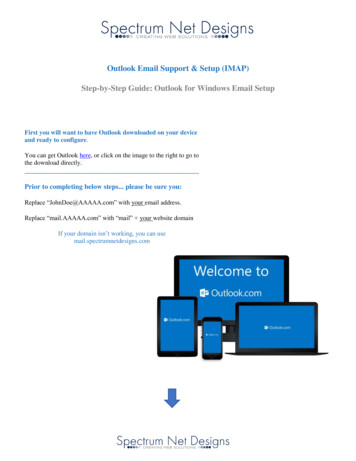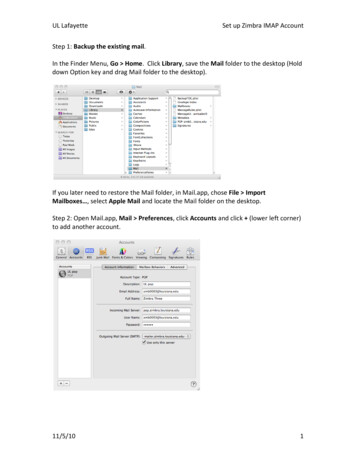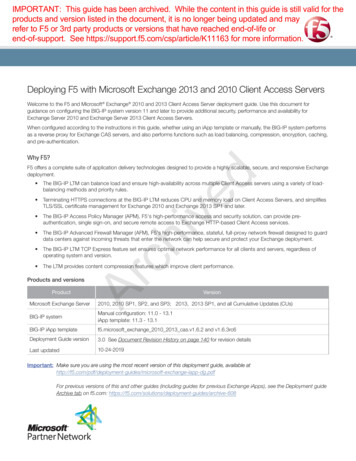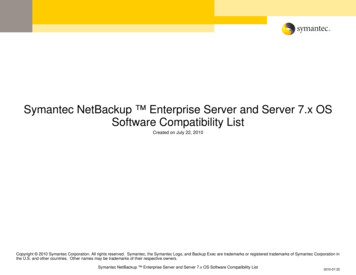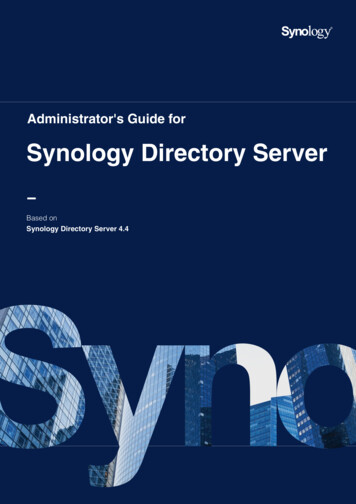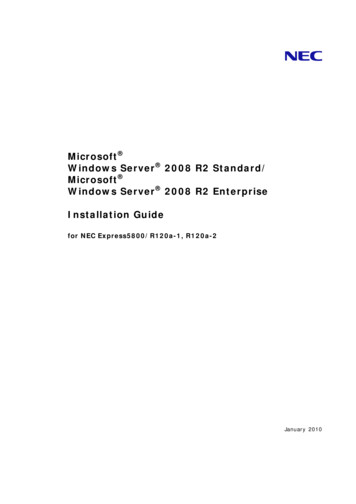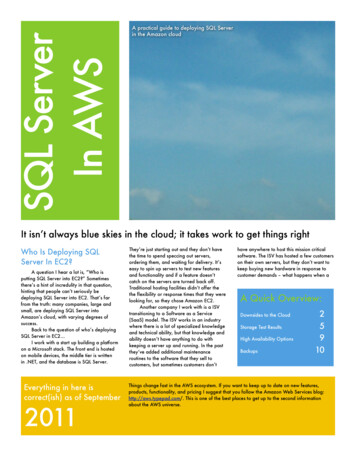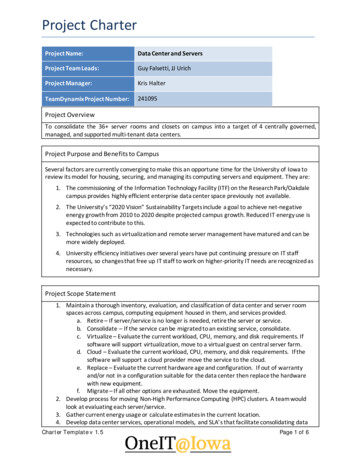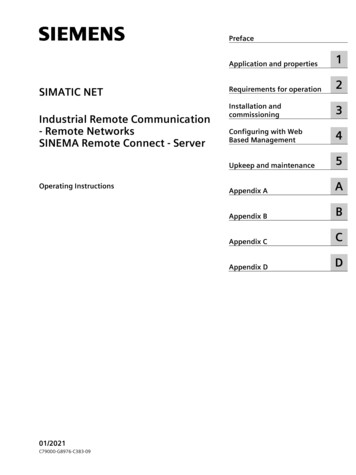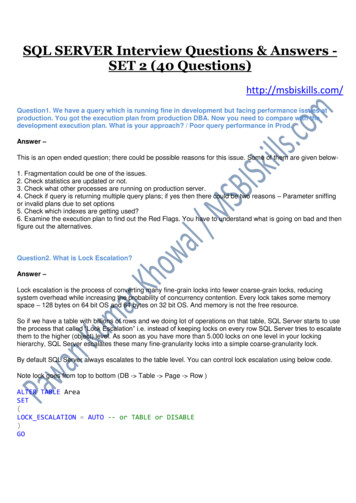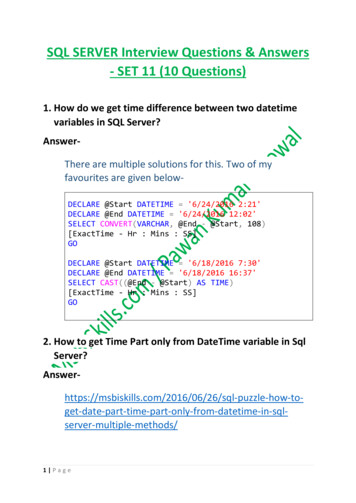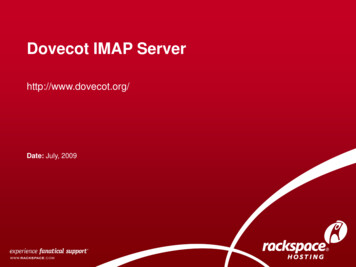
Transcription
Dovecot IMAP Serverhttp://www.dovecot.org/Date: July, 2009
Rackspace Email Dovecot is used to serve IMAP for over amillion paid mailboxes (MS Exchange alsoavailable) Users assigned to specific backend servers– With proprietary replication software Dovecot IMAP/POP3 proxies in front– Also for Exchange IMAP/POP3 users Amazon S3 for (encrypted) backups More about clustering later.
The Talk Dovecot featuresIMAP & Dovecot performancedbox mailbox formatClustering
DovecotPictures from Wikipedia, by Cyril Thomas and Carcharoth
History Dovecot design was started around June 2002First release was July 2002Late 2003 a redesign startedv1.0.0 released April 13th 2007v1.1.0 released June 21st 2008v1.2.0 released July 1st 2009v2.0 betas hopefully this year
Features Often has better performance than competition.– Optimized for minimizing disk I/O (index/cache files)– Hosting my own mails on 10 years old Sparc helps Highly configurable for different environments– Standard mbox and Maildir with transparent indexing(external mailbox modifications are ok)– dbox: Dovecot’s high-performance mailbox format– Many different ways of clustering– Extremely flexible authentication Postfix and Exim support Dovecot for SMTP AUTH
Features Admin-friendly / self-healing– All errors are logged– Understandable error messages– Improved constantly (to reduce my email load)– Detected (index) corruption gets fixedautomatically file dotlock create(/home/timo/Maildir/dovecot-uidlist) failed:Permission denied (euid 1000(timo) egid 1000(timo) missing x perm:/home/timo) chown(/home/timo/Maildir/.box, -1, 0(root)) failed: Operation notpermitted (egid 1000(timo), group based on /home/timo/Maildir)
v1.2 New Features Virtual mailboxes (search views)– ”All unread emails in all mailboxes”– All messages in all mailboxes (except Trash) Virtual POP3 INBOX For searching messages from all mailboxes gmail-like conversation views Users can share mailboxes to each others– IMAP ACL commands Modification sequences (CONDSTORE)– Custom code wanting quick sync? (e.g. backups)
Authentication Password and user database separation– Passdb for verifying user’s password– Userdb for looking up how to access mailbox Support for almost everything: SQL, LDAP,PAM, checkpassword scripts, etc.– Everything is configurable (e.g. full SQL queries)– Supports multiple dbs (e.g. system virtual users) Auth mechanisms: PLAIN, CRAM-MD5,DIGEST-MD5, Kerberos, OTP, etc. Password schemes: Plaintext, CRYPT, MD5,SHA1, SHA256, SSHA, SSHA256, etc.
Authentication Cache Passdb and userdb lookups can be cached Password changes are automatically detected:If auth is unsuccessful, and previous auth wasa) successful: do uncached passdb lookupb) usuccessful: fail login Negative caching can be disabled– User doesn’t exist caching– Password failures (v1.2 ) Avoids a need for imapproxy with webmails?
IMAP Protocol Base protocol is complex – difficult toimplement it correctly (both client & server) Flexible – many different ways to implement aclient (online & offline clients) Extensible – there are a lot of extensions– Clients rarely support more than some basicextensions, such as IDLE.– Thunderbird v3 adds support for several newextensions, such as CONDSTORE.
ImapTest IMAP Server Tester Written originally for Dovecot stress testing– Found a lot of crashes, hangs and mailbox corruptionon other IMAP servers as well Tests IMAP server compliance with scripted testsand dynamic random stress testing. Dovecot is currently the only IMAP server thatfully passes all of ImapTest tests. Panda IMAP is practically there too Most other servers fail in many different ways. http://imapwiki.org/ImapTest
Offline IMAP Clients Typically download newly seen messages’ bodiesonce and cache them locally Often can be configured to downloadimmediately vs. download when reading Some use server side searches (Thunderbird) andsome don’t (Outlook – if some messages haven’tbeen downloaded, those aren’t searched) Usually also fetch messages’ metadata once(headers, received date) Server-side caching may help, but not that much– It’s extra disk I/O - more likely just hurts
Online IMAP Clients Webmails often keep asking for the sameinformation over and over and over again Pine and some webmails cache what they’vealready seen, but not permanently Mutt (without local cache) and some othersfetch all messages’ metadata every time whenopening a mailbox Caching is very useful, but different clientswant different metadata
IMAP Server Performance Difficult to benchmark Depends a lot on clients: Whether clients usea local cache makes a huge difference.– Online vs. offline clients What data to index/cache? SPECmail2009 adds support for IMAP– Emulates different IMAP clients. Client amountsare configurable.– The only benchmark giving realistic results.
Dovecot Cache File dovecot.index.cache files The main reason for Dovecot’s good performance Dynamic: caches only what clients want.– Specific message headers (From:, Subject:, etc),– MIME structure information,– Sent / received date, etc. Caching decisions for each field: “no”, “temporary”,“permanent” Unused fields dropped after a month. Cached data never changes (IMAP guarantees) Cache file gets “compressed” once in a while Often about 10-20% of mailbox size
Dovecot Index Files dovecot.index contains messages’ metadata– IMAP Unique ID number (UID) identifies messages– Flags (\Seen, \Answered, keywords, etc.)– Extension data: mbox file offsets, cache fileoffsets, modseq number (v1.2 CONDSTORE), etc. Lazily created/updated since v1.1– dovecot.index.log has all the latest changes.dovecot.index is updated after 8 kB of new datahas been written to the .log
Dovecot Index Files dovecot.index.log is a mailbox transaction log– Somewhat similar to databases’ transaction logsor filesystem journals.– Contains all changes to be done to dovecot.index. dovecot.index is read to memory once andthen updated from dovecot.index.log– Very efficient with NFS / clustered filesystems!– Very efficient to find out what changes anothersession had done!
Plugins Dovecot plugins can hook into almost anythingand modify Dovecot’s behavior. Some existingfeatures implemented as plugins:––––Access Control ListsQuotaFull text search indexesReading compressed mbox/maildir files Can add new IMAP commands Implement new mail storage backends (virtual,SQL, IMAP proxying)
Mailbox Formats mbox– One mailbox one file Slow to delete old messages Maildir– One file one message Fast to delete messages Slow(er) to read through all messages File read order affects performance, even 2x or more! Single-dbox and multi-dbox– Dovecot’s extensible and high-peformancemailbox formats
Single-dbox Available in Dovecot v1.1 and later Main advantage over Maildir: filenames don’tchange. Directory layout looks like:– mailboxes/INBOX/dbox-Mails/ dbox.index – dbox index (removed in v2.0) dovecot.index* - Dovecot’s index files u.123 - Message data for IMAP UID 123 u.125 - Message data for IMAP UID 125– mailboxes/Trash/dbox-Mails/– mailboxes/Trash/temp/dbox-Mails/
Single-dbox Primary metadata storage is Dovecot’s indexfiles Metadata backups written about once a day todbox files - losing indexes won’t lose all flags Automatically fixes/rebuilds broken/lostindexes Future: Dovecot v2.0 no longer writes flags todbox files. It creates separate index filebackups instead.
dbox File Format File header– Message header size– File creation data Message header (extensible)– Message size Message body Message metadata (extensible)––––Message’s globally Unique ID (GUID)Receive and save date/timeMessage’s ”virtual size”etc. [multi-dbox: Next message ]
Single-dbox: Maildir Migration Superfast migration from Maildir:– Renames Maildir/cur/ to dbox-Mails/– Moves other useful Maildir files too New mails will be saved using native dboxformat Old mails get converted to dbox later whenuser changes old mails’ flags.– Mails might stay as Maildir for a long time
Single-dbox: Alternative Storage Users rarely access their old mails Lower performance storage is cheaper- Move old mails to low performance storage dbox supports ”alternative path” setting: If adbox file isn’t found from primary path, it’slooked up from alternative path.– mail location dbox: /dbox:ALT /slow/%u/dbox Future: Support for cloud storage (likeCloudFiles/S3)?
Multi-dbox Available in upcoming Dovecot v2.0 Multiple messages in a single file Multiple files in a single mailbox––––Files are about 2 MB (configurable)Can be rotated every n days (for incremental backups)Larger files - less fragmentation, but deletion slowerDelayed ioniced nightly deletions Tries very hard to preserve as much data aspossible in case of (filesystem) corruption. Crash or power loss can’t corrupt or lose data
dbox Future Single instance attachment storage Abstract out filesystem access and implement– Regular POSIX I/O– Async I/O– Cloud storage I/O Make Dovecot do more parallel processing toget good performance for (high latency) cloudstorage and to get full advantage of async I/O.
Dovecot Clustering Two different ways to do it: Globally shared filesystem– Many IMAP servers, each able to handle any user– NFS, cluster filesystems Sharding– Each user’s data mirrored in 2-3 servers– IMAP proxy forwards users to correct server(s)– DRBD, proprietary clustering software/hardware
Clustering: Two Types of Data Message data– Existing messages (files) don’t change– Users typically read messages once - message isread from disk only once (or few times)– Latency hurts, but not badly (in future even less) Index data– Constant lookups: ”Has mailbox changed?”– Latency is very bad for performance– Existing files change constantly - caching trouble! Different storages for messages/index?
Clustering: NFS NFS server is often single point of failure– Performance problems affect everyone. Might bedifficult to diagnose/fix.– Example: NFS locking broke - restarted - Dovecot became unusably slow Caching problems, especially with index files– mail nfs * settings try to solve these Index files on local disk helps performance http://wiki.dovecot.org/NFS
Clustering: NFS Sticky servers for users only one servermodifies a user’s mailbox– IMAP proxy looks up destination server from db– Avoids caching problems– If mail delivery updates indexes, must be done bythe same server as IMAP. Each server receives mails with SMTP/LMTP– Storing indexes on local disks helps performance If server goes down, reindexing may be slow DRBD hybrid?
Clustering: Cluster FS Dovecot known to work with GFS, OCFS2, . Less caching problems than with NFS– Performance still better when user accesses onlysingle server (better caching, less lock waits) Performance?– Many small files are bad?
Clustering: Sharding Typically in active/passive server pairs: Dedicated active and passive servers– Wastes servers Crossed pairs– Each server is active for one set of users andpassive for another set of users– Server failure doubles the passive’s load Dovecot IMAP/POP3 proxy cluster in front
Clustering: Sharding Distribute individual users (not entiredomains) to different servers– Reduces load spikes Use statistics to automatically distribute heavyusers to different servers– v1.2 can export very detailed statistics via plugin– v2.0’s upcoming dsync utility
Clustering: DRBD Filesystem corruption gets replicated Synchronous replication– No mail loss on failures– Too slow for cross-datacenter(?) Asynchronous replication– Some data loss on failure 3 servers: Sync replication for in-datacenterand async for cross-datacenter backup?
Clustering Future: The Cloud Save message data in cheap cloud storage– Typically simple APIs to access files dbox designed for this– Typically higher latency Dovecot needs to do more work while waiting Index data kept primarily in memory– Must be very low latency - direct communicationbetween servers that access the same mailbox– Permanent (backup) storage may still be in cloud Result: multi-master replication
Dovecot v2.0 Some new features already implemented:– Redesigned master process Easy to add external services, e.g. ManageSieve– Redesigned configuration Local/remote IP/mask -specific configuration– SSL certs Allow changing config data source (e.g. SQL?)– LMTP server– dsync: Realiably and efficiently sync two mailboxes(e.g. via SSH)
Dovecot v2.0 Features not yet implemented, but hopefullywill be by the end of this year:– Index file improvements No locking (with atomic appends) Small checksums all around for detecting corruption In general make the code simpler and more robust– Multi-master replication dbox cloud storage (for some existing cloud API(s)?) Index sharing/replication between servers
Questions?
Rackspace Email Dovecot is used to serve IMAP for over a million paid mailboxes (MS Exchange also available) Users assigned to specific backend servers – With proprietary replication software Dovecot IMAP/POP3 proxies in front – Also for Exchange IMAP/POP3 users Amazon S
